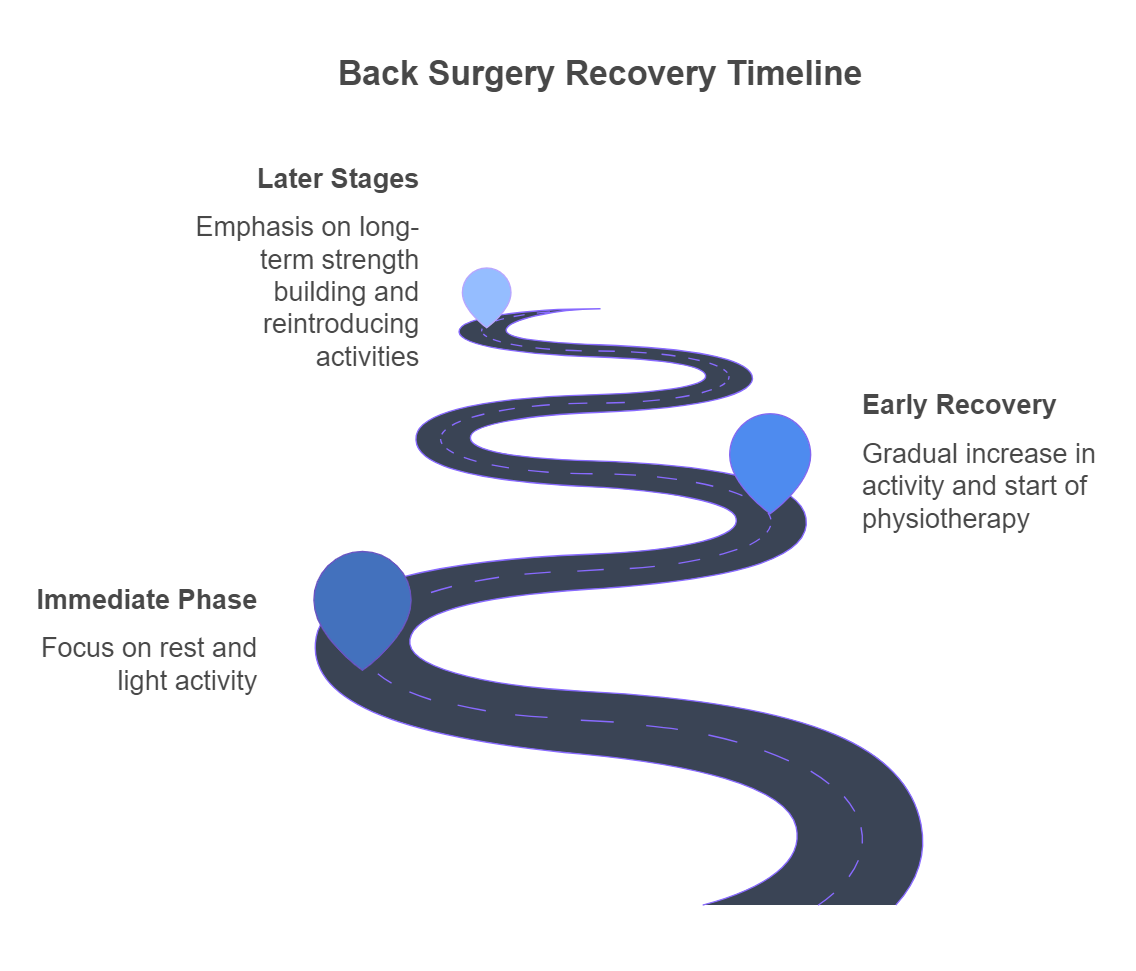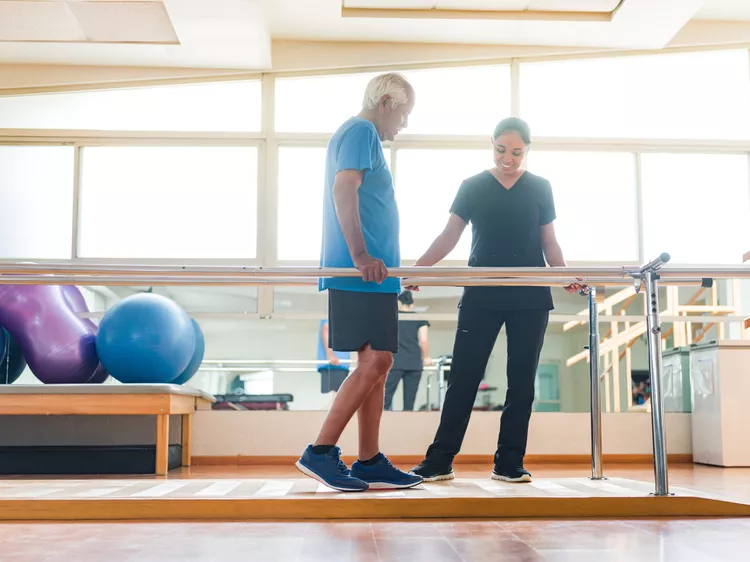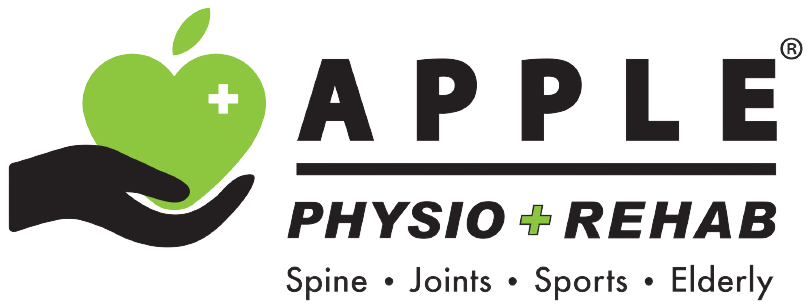Back surgery is often the first major step toward reclaiming mobility and reducing chronic pain. However, surgery alone doesn’t guarantee a return to full function—it’s just the beginning of the recovery journey.
Proper after-surgery care is crucial to ensure the effort invested in the operating room truly pays off. It minimises complications, accelerates healing, and improves your overall quality of life.
There are plenty of options for post-surgery care in Malaysia. At Apple Physio, we understand the challenges and uncertainties that come with life after back surgery. So here are some essential tips and practical advice to help you navigate your recovery safely and effectively.
Back Surgery Recovery Timeline
Recovering from back surgery isn’t a one-size-fits-all process, but here’s a general timeline for you to grasp the process of back pain recovery in KL at our centre to ease your mind.

Immediate Phase (Weeks 1–2)
Rest is Key: While resting is crucial, complete immobility can do more harm than good. Unless your surgeon advises otherwise, gentle movements are encouraged.
Light Activity: Short walks around the house help prevent stiffness and improve circulation, which is vital for the healing process.
Early Recovery (Weeks 3–6)
Gradual Activity: Slowly increase your activity levels under supervision. Avoid any sudden or aggressive movements.
Start Physiotherapy: This phase often marks the beginning of physiotherapy. Sessions focus on restoring mobility and rebuilding muscle strength.
Later Stages (Months 3 –6)
Long-Term Strength Building: Tailored physiotherapy programs help strengthen core and back muscles, improving flexibility and stability.
Reintroducing Activities: Low-impact exercises like swimming, yoga, or cycling can gradually be added to your routine. Always consult your physiotherapist before starting any new activities.
How to Get Rid of Back Pain – Do’s and Don’ts Post Surgery
| Do’s | Don’t’s |
| Practice Proper Body Mechanics | Ignore Muscle Relearning |
| Hand Support When Getting Out of Bed | Avoid Driving Too Soon |
| Wear Slip-On Shoes | Say No to Non-Recommended Supplements |
| Track Your Progress | Sleep on Your Stomach or any other uncomfortable position |
| Stay Hydrated & Maintain A Well-balanced Diet | Skip Scheduled Rest Days |
Recovery is all about finding balance. Knowing what to do—and what to avoid—can significantly impact your healing process.
Do’s
- Practice Proper Body Mechanics: When picking up items, squatting is safer than bending over. This protects your spine and minimises strain.
- Hand Support When Getting Out of Bed: Even if it is out of habit, avoid twisting your back. Instead, roll onto your side, use your arms to push yourself up, and swing your legs off the bed.
- Wear Slip-On Shoes: Even if you’re used to shoes with laces, for the time being, switch to comfortable slip-on footwear instead. Bending over to tie laces can strain your back.
- Track Your Progress: Maintain a recovery journal to log pain levels, mobility, and daily activities. This helps your physiotherapist tailor your rehabilitation plan and will give you a sense of accomplishment.
- Stay Hydrated & Maintain A Well-balanced diet: Spinal discs need hydration to maintain elasticity and support recovery. Aim for consistent water intake throughout the day. Also maintain a well-balanced diet for quicker recovery.
Don’ts
- Don’t Ignore Muscle Relearning: Back muscles play a vital role in supporting your spine. Skipping exercises that engage these muscles can slow recovery and increase re-injury risks.
- Avoid Driving Too Soon: Driving requires twisting and sudden movements. Wait until your surgeon clears you to get behind the wheel.
- Say No to Non-Recommended Supplements: Over-the-counter supplements like omega-3s can thin the blood and interfere with healing. Always consult your doctor before adding supplements.
- Don’t Sleep on Your Stomach: This position can strain your spine. Sleep on your back with a pillow under your knees or on your side with a pillow between your legs for optimal alignment.
- Don’t Skip Scheduled Rest Days: Overdoing activities, even light ones, can set back your recovery. Balance movement with adequate rest.
The Role of Physiotherapy in Post-Surgery Rehabilitation

Physiotherapy isn’t just a part of recovery—it’s a cornerstone. At Apple Physio Rehab, we design personalised rehabilitation plans tailored to your specific needs.
Pain management techniques such as manual therapy, stretching, and heat or cold applications reduce pain and inflammation, making daily activities more manageable. You can also rebuild your strength by exercising core and back muscles. This would also prevent re-injury and support long-term recovery.
Joint mobilisation and targeted exercises help restore your range of motion, ensuring you regain flexibility and ease of movement. Preventing Long-Term Issues: Addressing imbalances, weak muscles, and poor posture now helps avoid complications later and prevents long-term issues.
3 Practical Tips for Daily Life Post-Surgery

Any surgery would definitely affect the way we live our lives. It involves making some ergonomic adjustments and forming healthy habits. These tips are good for the long run. After all, we’re using our bodies for as long as we live.
-
Ergonomic Adjustments
It is best to Invest in supportive chairs and mattresses to maintain proper spinal alignment. Make sure your workstation reduces strain—your computer screen should be at eye level, and your chair should support your lower back.
-
Movement Hacks
Use tools like grabbers to pick up objects without bending. Practice safe techniques for sitting, standing, and lifting to avoid unnecessary strain.
-
Lifelong Healthy Habits
Maintain an active lifestyle and continue your physiotherapy exercises at home. Prioritise rest and maintain a positive mindset—recovery is a marathon, not a sprint.
Frequently Asked Questions (FAQ)
Q: How soon can I start physiotherapy after back surgery?
A: Physiotherapy typically begins 2–3 weeks post-surgery, but this depends on your progress and surgeon’s recommendations.
Q: Will I fully recover after back surgery?
A: Recovery varies by individual. Following your physiotherapy plan and practising proper care improves your chances of a full recovery.
Q: Can I travel long distances during recovery?
A: Long trips are generally discouraged during the first 4–6 weeks. Sitting for extended periods can strain your back and might affect recovery.
Q: What are the warning signs of complications?
A: Redness, swelling, increased low back pain, sudden weakness or fever could indicate an infection. Contact your doctor immediately if you notice these symptoms.
Apple Physio Rehab For Your Back Pain Treatment in Malaysia

Life after back surgery requires patience, commitment, and the right guidance. Proper post-surgery care isn’t just about healing—it’s about building a foundation for a pain-free, mobile life.
At Apple Physio Rehab, we’re here to support you every step of the way. From pain management to mobility improvement, our tailored physiotherapy services and back pain treatments in Malaysia are designed to help you achieve a full and lasting recovery.
Ready to take charge of your recovery journey? Contact Apple Physio Rehab today to start your personalised back plan. Together, we’ll get you back to living your best life.




